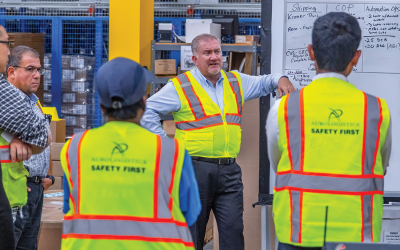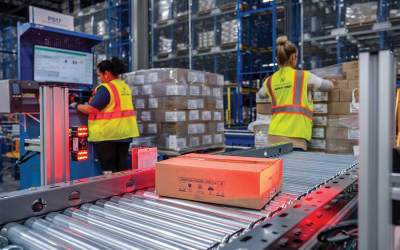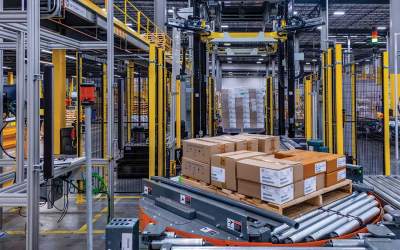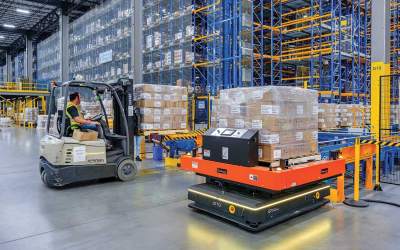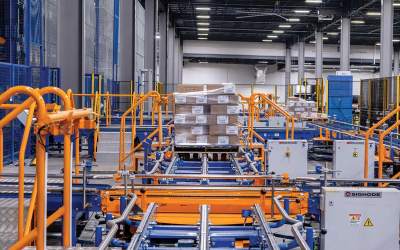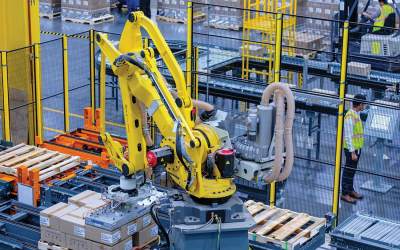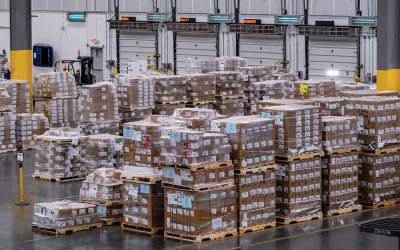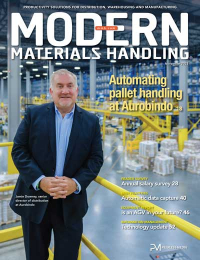Automating pallet handling at Aurobindo
One of the world’s leading generic drug manufacturers turned to AS/RS technology to optimize its pallet-centric operations and enable growth.

If you attended ProMat last spring, it was easy to believe that out in warehouse land, it’s all e-commerce and robots all the time. Piece picking rules the day; pallets are passée.
Yet, pallets and pallet handling solutions still play an important role in getting orders out the door. In industries like food and beverage, consumer packaged goods and pharmaceuticals, pallets and cases are the most common way of moving product. Companies in those industries are still turning to automation to reduce touches, speed up the movement of product through their facilities, optimize space and, like their e-commerce counterparts, keep up with growth.
Get a more in depth look at the systems in place at Aurobindo here: "Moving pallets at Aurobindo"
In fact, growth was a primary reason that Aurobindo, a leading manufacturer and distributor of generic drugs to wholesale distributors, retailers, hospitals and doctor offices, implemented a high-density, high-speed automated storage and retrieval system (AS/RS) at a 550,000-square-foot distribution center in East Windsor, N.J. The facility, one of two buildings on the North American headquarters campus, currently uses 350,000 square feet of the space for warehousing and distribution.
“Annual growth was hovering between 25% and 30% when Aurobindo began to investigate automation a few years ago,” says Jamie Downey, the senior director of distribution who joined the firm after the AS/RS was up and running. “We had to automate our manual pallet-handling systems to keep up.”
The solution was a three-module AS/RS that has since been expanded to five modules. The AS/RS is managing an estimated 19,000 pallets with room to store up to 34,000 pallets. Thanks to a modular design, the AS/RS can be expanded to enable more growth. Module 1 handles partial pallets while modules 2 through 5 handle full pallets.
The AS/RS features separate modules designated for incoming pallets to replenish the system and outbound pallets going to one of the pick modules or to shipping for full pallet orders. It can handle as many as 300 pallets an hour both inbound and outbound.
“We would not be able to fulfill our demand without this kind of system. If we were still a manual operation, we would not be who we are today.” - Downey
Automating for growth
Aurobindo Pharma, Aurobindo’s parent company, was founded in India in the late 1980s with one facility in the city of Pondicherry to manufacture Semi-Synthetic Penicillin (SSP). Growth came quickly, and by 1995, the company was listed on the Indian stock exchanges.
Today, Aurobino Pharma is the market leader in SSP. It also has a presence in key therapeutic segments such as neurosciences (CNS), cardiovascular (CVS), anti-retroviral, anti-diabetics, gastroenterology and antibiotics.
Over the years, the company diversified its offerings to include specialty generic drug formulations as well as manufacturing active pharmaceutical ingredients and formulation products. In addition to its global headquarters in India, it has operations around the globe, including the United States, Brazil, Portugal, South Africa and Canada. All told, Aurobindo generates an estimated $3 billion a year in revenue across its global portfolio of products.
Aurobindo Pharma USA was incorporated in 2004 and began manufacturing product in the United States in 2006. The U.S. headquarters moved to East Windsor, N.J., in 2016, and its state-of-the-art DC opened a year later. The facility replaced a smaller conventional warehouse in Dayton, N.J., with 8,000 pallet positions that could no longer keep up with the growth.
“This location is our only distribution facility in the U.S.,” Downey explains. “Everything is shipped here and then processed from here, so it has to be efficient.” The facility moves an estimated 15 million units per month across three divisions: prescription drugs, over-the-counter drugs and an injectable division for elective surgeries. Aurobindo is the leading distributor of generic prescription drugs in the country by transaction.
Downey describes the new facility as “a classic growth story. Aurobindo needed more capacity to meet growing demand.” The new facility features 20 dock doors for receiving, compared to four in the old conventional facility, and 16 doors for shipping compared to two before. “The additional doors give us much more versatility and flexibility when it comes to transportation planning and management,” Downey says.
And, as previously noted, the old facility was a conventional facility with manual pallet rack, and it’s still run with a skeleton crew today to distribute highly regulated and controlled substances. Downey adds that the company is in the process of moving that part of the business to East Windsor.
Transitioning to automation
The transition to automation took place over several years. The system was expanded with the addition of more modules to handle more pallets. What’s more, adds Downey, Aurobino’s operations needed to adapt to new processes. “I was not here when the system went live,” he recalls, “but I was brought in to help optimize the system after we made the transition to automation. I’m not an automation expert, but I am an expert on integrating humans and automation. I’ve worked in highly automated facilities throughout my career.”
When Downey joined Aurobindo, the facility still had manual operations for its over-the-counter and injectables business, reserving automation for filling orders for generic prescription drugs, which is the bulk of the business.
By the end of 2022, that business had been consolidated into the AS/RS that now accounts for 95% of the activity in the building. What’s more, about 65% of the activity involves full pallets, with a pallet build area reserved to create mixed or partial pallets from donor pallets retrieved from the system.
“The AS/RS is the heart of our facility and gives us a lot of efficiency on the production side of our business. If we get an order for 10 truckloads of product, the system can retrieve those 500 pallets very quickly.” - Downey
It also enables flexibility, conveying donor pallets to the pick stations. “The AS/RS never gets sick and never has a bad day,” Downey points out. “It provides reliability and a cadence to the building.”
The system’s management software provides a new level of inventory control beyond managing the storage locations of pallets, including lot and expiration date information. Downey says that capability will be critical to Aurobindo’s ability to comply with the upcoming federal Drug Supply Chain and Security Act (DSCSA). “Serialization is one of the requirements of the act, and this system will allow us to be in compliance,” he says.
While the AS/RS represented Aurobindo’s entrance into automation, Downey says the company is not done. Rather, his team is exploring the addition of new automation to complement and extend the gains from the AS/RS.
A starting point is automation at the dock. When the facility was built, Aurobindo received palletized container loads from India. Before the pandemic, they transitioned to floor-loaded containers. That change reduced the annual transportation spend by about 30% by getting more product into the containers. This was a boon during the pandemic when the cost of container shipping skyrocketed.
On the inbound side, however, that resulted in the need for more labor to manually unload containers. Downey says the distribution team investigated robotics to automatically unload the containers; robots weren’t practical because of the variety of carton sizes received at the facility.
Instead, Aurobindo plans to install telescoping boom conveyors designed to integrate with the existing conveyor system. “I’ll have two people unloading onto the conveyor and from there, it will be one touchpoint before putaway,” Downey says.
A second project in the planning stage involves the installation of a robotic palletizer to automatically build pallets for storage in the AS/RS, streamlining the current manual pallet building process. Finally, Downey has brought in autonomous mobile robots (AMRs) for non-value-added pallet handling. “We’re working with two AMRs to get our feet wet,” he says.
What’s driving the move to automate? For starters, it furthers the original goal to have a state-of-the-art automated facility. The second, Downey says, isn’t so much the return on investment as a risk management tool.
“We need to be less reliant on human capital for the jobs in the warehouse that people don’t want to do any more,” Downey says. “This system, and the automation that we’re adding, will take us into the future.”

Article Topics
Automation News & Resources
Materials Handling Robotics: The new world of heterogeneous robotic integration Coles automates grocery distribution in Australia 2024 Intralogistics Robotics Survey: Robot demand surges Up close and personal with mind twisting special purpose robots Warehouse automation extends life of cheese DC by a decade C-Suite Interview with Knapp’s Josef Mentzer: MODEX 2024 eclipses expectations MEGALINEAR MLR-45: Innovation in Logistics and Material Handling More AutomationLatest in Materials Handling
Geek+ and System Teknik deploy PopPick solution for pharmacy group Med24.dk Beckhoff USA opens new office in Austin, Texas Manhattan Associates selects TeamViewer as partner for warehouse vision picking ASME Foundation wins grant for technical workforce development The (Not So) Secret Weapons: How Key Cabinets and Asset Management Lockers Are Changing Supply Chain Operations MODEX C-Suite Interview with Harold Vanasse: The perfect blend of automation and sustainability Consultant and industry leader John M. Hill passes on at age 86 More Materials HandlingAbout the Author
Subscribe to Materials Handling Magazine

Find out what the world's most innovative companies are doing to improve productivity in their plants and distribution centers.
Start your FREE subscription today.
April 2024 Modern Materials Handling

Latest Resources


